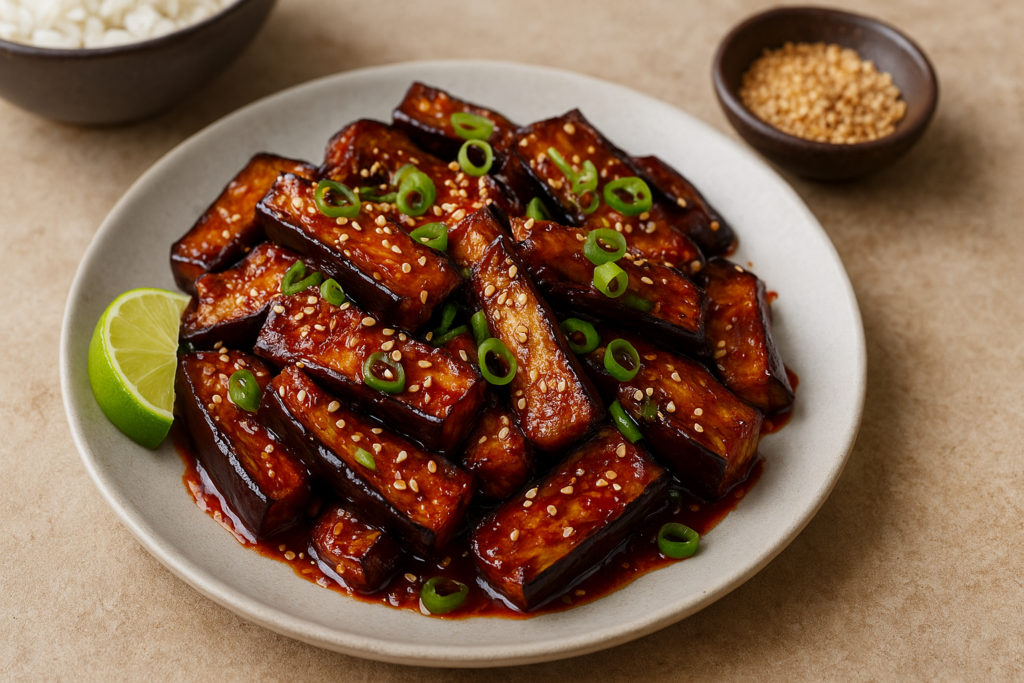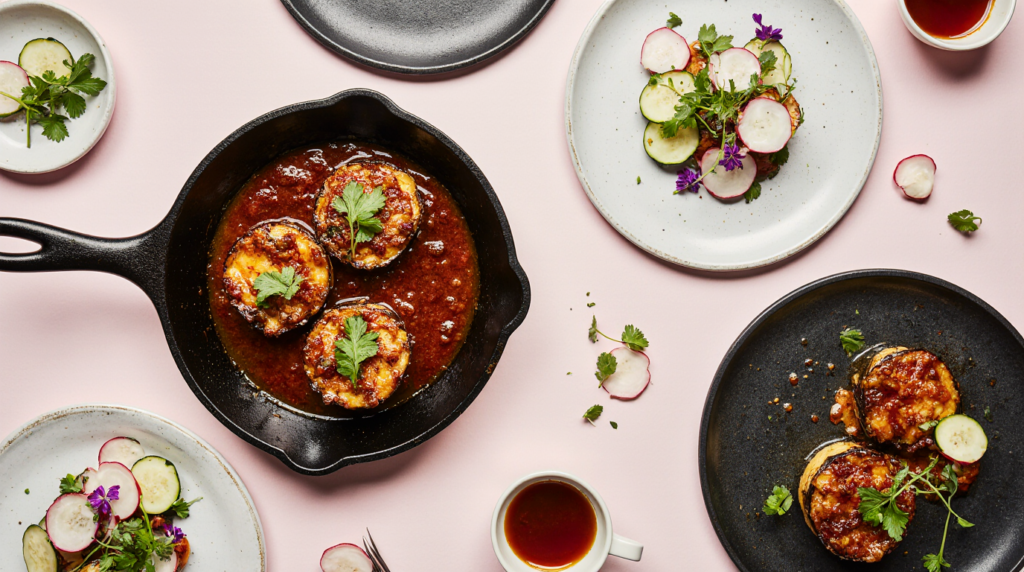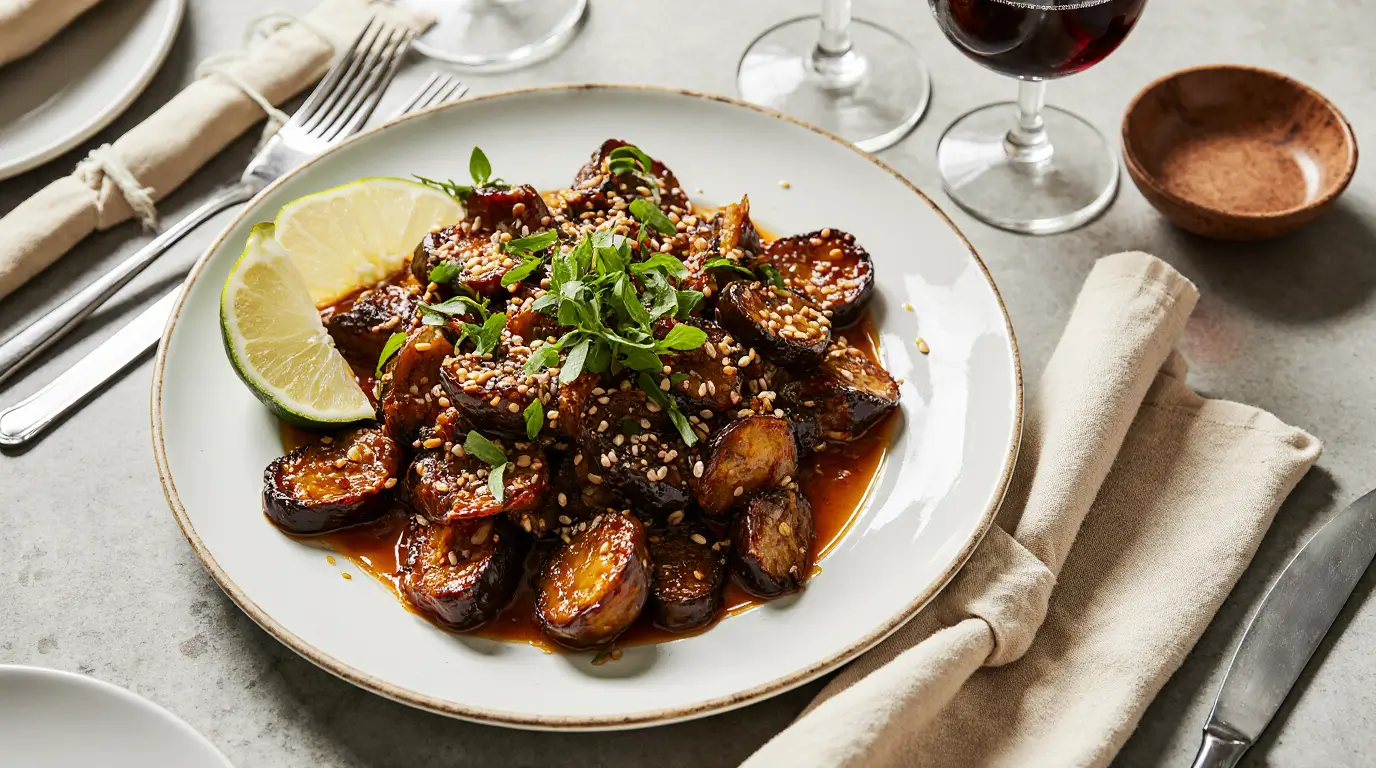Korean Spicy Eggplant Recipe – The Must-Try You’ll Love
When my Korean neighbor Mrs. Kim handed me a container of her homemade gochujang eggplant over the fence three summers ago, I had no idea it would completely change the way I saw eggplant. One bite of that glossy, caramelized perfection — where sweet honey meets the complex heat of gochujang and the brightness of lime — and I was hooked.
This Korean spicy eggplant recipe transforms a humble vegetable into an addictive, restaurant-worthy dish that bridges traditional Korean flavors with bold, modern tastes. Unlike the soggy, bland versions many remember from childhood, this gochujang-glazed creation balances sweet, spicy, and umami in every bite.
“Gochujang-glazed” simply means the eggplant is coated in a sticky, spicy-sweet Korean chili paste sauce that caramelizes as it cooks, giving it that irresistible shine and bold flavor.”
The magic happens when silky eggplant meets fermented gochujang heat — my secret weapon for converting even the most stubborn eggplant skeptics. This is comfort food with serious attitude.
Table of Contents
Why This Korean Eggplant Recipe Will Become Your New Kitchen Obsession
- Features perfectly tender eggplant with a caramelized, sticky glaze
- A Korean spicy eggplant recipe that delivers restaurant-quality results at home
- It’s naturally vegan and gluten-free when tamari is used instead of soy sauce.
- Ready in only 25 minutes using straightforward cooking methods.
- Transforms affordable ingredients into gourmet Korean comfort food
- This easy gochujang eggplant recipe works for beginners and experienced cooks alike
From Humble Vegetable to Korean Street Food Star
Eggplant dishes have been staples in Korean cuisine for centuries, but this particular preparation gained popularity in Korean street food markets before making its way into home kitchens. The combination of gochujang’s fermented complexity with honey’s natural sweetness creates a flavor profile that satisfies both traditional Korean palates and adventurous American food lovers.

The Perfect Storm of Korean Flavors
The brilliance of this Korean spicy eggplant recipe lies in its masterful balance of opposing forces. Creamy, mild eggplant serves as the ideal base for gochujang’s complex heat, while honey adds caramelized sweetness and lime provides a bright acidity that balances the richness. The result is a dish that satisfies every taste bud and keeps you coming back for more.
How This Recipe Became My Go-To Crowd Pleaser
I’ll never forget the first dinner party where I served this gochujang eggplant. My friend Sarah, who’d sworn off eggplant since a traumatic childhood experience with mushy moussaka, took one tentative bite and then immediately asked for the recipe. That’s the power of properly prepared eggplant with Korean flavors – it converts even the most dedicated skeptics.
| Feature | Traditional Eggplant Dishes | Korean Spicy Eggplant Recipe |
|---|---|---|
| Flavor Profile | Often bland, one-dimensional | Complex, multi-layered umami |
| Texture | Frequently mushy | Perfectly tender with caramelized exterior |
| Visual Appeal | Usually dull appearance | Glossy, restaurant-worthy presentation |
| Cooking Method | Basic roasting or frying | Strategic glazing technique |
| Crowd Appeal | Mixed reactions | Universal crowd-pleaser |
Sourcing Authentic Korean Ingredients: Your Shopping Strategy
Creating an exceptional Korean spicy eggplant recipe requires understanding where to find authentic ingredients and how each component contributes to the final dish. Quality gochujang makes all the difference in this recipe, so invest in the best you can find.

Shopping List with Precise Measurements
Fresh Produce Essentials:
- 2 large Japanese or Chinese eggplants (about 2 lbs total) – the foundation of this Korean recipe
- 3 cloves fresh garlic, minced (9g)
- 1 inch fresh ginger, grated (8g) – adds warming spice
- 2 green onions, chopped (30g) – for fresh finish
- 1 lime, juiced (30ml) – essential brightness
Korean Pantry Must-Haves:
- 3 tablespoons gochujang paste (45g) – the star of Korean spicy dishes
- 2 tablespoons honey (30ml) – creates that addictive glaze
- 2 tablespoons soy sauce or tamari (30 ml) for a rich umami flavor
- 1 tablespoon rice vinegar (15ml) – subtle tang
- 2 tablespoons neutral oil for cooking (30ml)
- 1 teaspoon sesame oil (5ml) – finishing touch
- 1 tablespoon toasted sesame seeds (8g) – for garnish
Gochujang Selection Guide
The key to an authentic Korean spicy eggplant recipe is using quality gochujang. Look for brands like Chung Jung One or Mother-in-Law’s in the Asian foods aisle. Avoid versions with excessive corn syrup – the best gochujang should taste complex and fermented, not just sweet and spicy.
Dietary Modifications for Modern Lifestyles
Low-Sodium Adaptation: Reduce soy sauce and use low-sodium versions of both soy sauce and gochujang without compromising the essential Korean flavors in this recipe.
Sugar-Free Version: Replace honey with sugar-free maple syrup or monk fruit sweetener, though this will slightly alter the caramelization properties of this gochujang eggplant dish.
Timing Your Korean Cooking Adventure
Understanding the preparation timeline ensures perfect results for this Korean spicy eggplant recipe. The cooking process requires attention during the glazing phase but rewards you with incredible flavor development that transforms simple ingredients.
Preparation and Cooking Schedule
Active cooking time for this Korean spicy eggplant recipe totals approximately 20 minutes, including prep and glazing. The secret is having your mise en place ready since the glazing happens quickly once you start cooking.
Temperature Control for Perfect Results
Eggplant performs best when cooked at medium-high heat for proper caramelization, while the gochujang glaze requires careful temperature management to prevent burning. The lime juice should be added at the very end to preserve its bright acidity in this Korean recipe.
| Cooking Phase | Temperature | Duration |
|---|---|---|
| Eggplant Initial Cooking | Medium-high (375°F) | 8-10 minutes |
| Glaze Addition | Medium (325°F) | 3-4 minutes |
| Final Assembly | Off heat | 2 minutes |
Make-Ahead Strategy for Busy Weeknights
While this Korean spicy eggplant recipe tastes best served immediately, you can prepare the gochujang glaze up to 24 hours ahead. Store covered in the refrigerator and allow to come to room temperature before serving. The eggplant is best cooked fresh for optimal texture.
Step-by-Step Mastery: Creating Korean Restaurant Magic
Follow this detailed approach to create a Korean spicy eggplant recipe that rivals your favorite Korean restaurant. Each step builds layers of flavor that transform humble eggplant into an extraordinary dish worthy of special occasions.
Essential Eggplant Preparation Techniques
Eggplant Selection and Prep:
- Choose firm eggplants with glossy skin and green stems
- Cut into 1-inch thick rounds or long wedges for even cooking
- Salt lightly and let drain for 15 minutes to remove bitterness
- Pat completely dry before cooking to ensure proper caramelization
Korean Glaze Preparation:
- Whisk together gochujang, honey, soy sauce, and rice vinegar until smooth.
- Prepare garlic and ginger for quick addition
- Have lime juice ready for final brightening
Mastering the Korean Cooking Technique
Perfect Eggplant Cooking:
- Heat oil in large skillet over medium-high heat
- Cook eggplant pieces without overcrowding, 4-5 minutes per side
- Look for golden-brown caramelization before flipping
- Remove eggplant temporarily while preparing glaze
Signature Glaze Application:
- Reduce heat to medium and add garlic and ginger to the same pan.
- Cook aromatic base for 30 seconds until fragrant
- Add prepared gochujang mixture and simmer until slightly thickened
- Return eggplant to pan and toss to coat completely
Final Assembly for Korean Authenticity
Professional Plating: Arrange glazed eggplant on serving platter, drizzle with any remaining glaze, and finish with fresh lime juice.
Authentic Garnish: Top with chopped green onions, toasted sesame seeds, and a drizzle of sesame oil for true Korean restaurant presentation.

Nutritional Power Meets Korean Flavor
Each serving of this Korean spicy eggplant recipe provides excellent nutrition while maintaining moderate calories. This healthy Korean dish offers fiber, antioxidants, and beneficial compounds from whole, plant-based ingredients.
| Nutrient | Amount per Serving |
|---|---|
| Calories | 145 |
| Total Fat | 8g |
| Saturated Fat | 1g |
| Cholesterol | 0mg |
| Sodium | 420mg |
| Total Carbohydrates | 18g |
| Dietary Fiber | 5g |
| Protein | 3g |
| Vitamin K | 4% DV |
| Folate | 6% DV |
This Korean spicy eggplant recipe serves 4 as a side dish or 2 as a main course and scales beautifully for larger gatherings.
Pro Tips for Korean Cooking Success
Elevate your Korean spicy eggplant recipe from good to extraordinary with these insider techniques I’ve learned from Korean cooking experts and countless iterations of perfecting this dish.
Critical Mistakes That Ruin Korean Eggplant
Steer clear of these common mistakes that can ruin your gochujang eggplant:
- Overcrowded pan: Too much eggplant prevents proper caramelization
- Wrong heat level: Too high burns the gochujang, too low makes soggy eggplant
- Skipping the salt step: Not salting eggplant results in bitter, watery results
- Cheap gochujang: Low-quality paste lacks the complex fermented flavors this Korean recipe needs
Advanced Korean Cooking Techniques
Temperature Layering: Start with high heat for eggplant caramelization, then reduce for glaze application to prevent burning the gochujang.
Flavor Building: Allow the glaze to reduce slightly in the pan before adding eggplant back – this concentrates the Korean flavors and creates better coating.
Creative Variations on Korean Eggplant
International Fusion Adventures
Transform this Korean spicy eggplant recipe by adding Mediterranean elements like fresh basil and balsamic reduction, or go Mexican-fusion with cilantro and lime crema. Each adaptation maintains the core gochujang flavor while exploring new culinary territories.
Social Media-Worthy Presentation
Elevate your plating with colorful garnishes like thinly sliced radishes, microgreens, or edible flowers. For Instagram appeal, serve in individual cast iron skillets or arrange on dark slate plates that make the glossy glaze pop.

“Transform this Korean spicy eggplant recipe into an elegant appetizer by serving on small spoons with pickled cucumber – perfect for Korean-themed dinner parties!”
Perfect Korean Meal Pairings
Complete your Korean dining experience by pairing this gochujang eggplant with complementary dishes and beverages that enhance the overall flavor journey.
Ideal Korean Accompaniments
Traditional Korean Sides:
- Steamed jasmine or short-grain rice to balance the spice
- Quick kimchi for probiotic contrast
- Korean cucumber salad for cooling freshness
Modern Fusion Options:
- Cauliflower rice for low-carb alternative
- Quinoa bowls with sesame dressing
- Asian-inspired slaws with sesame-ginger vinaigrette
Beverage Pairings for Korean Flavors
Perfect Drink Matches:
- Cold barley tea (bori-cha) – a traditional Korean tea with a toasty, nutty flavor that complements spicy dishes perfectly
- Green tea or oolong tea – traditional and cleansing, balancing the heat of gochujang
- Sparkling water with cucumber – a refreshing palate cleanser
- Korean citron tea (yuja-cha) – a sweet and tangy citrus drink that soothes and brightens the flavors
These combinations create an authentic Korean dining experience that showcases this spicy eggplant recipe beautifully.
Storage Mastery and Leftover Magic
Your Korean spicy eggplant recipe adventure extends beyond the first meal. Understanding proper storage and creative reuse ensures you get maximum value from this flavorful dish.
Keep leftover Korean eggplant covered in the refrigerator for up to 3 days. The flavors actually improve overnight as the gochujang marinates the eggplant further. Reheat gently in a skillet with a splash of water to refresh the glaze.
For meal prep success with this Korean spicy eggplant recipe, cook the eggplant and store the glaze separately. Combine and reheat when ready to serve for optimal texture.
Transform leftovers into Korean-inspired grain bowls, add to ramen for extra flavor, or chop and use as a pizza topping for fusion creativity.
FAQ: Your Korean Cooking Questions Answered
What makes gochujang different from other chili pastes in this Korean spicy eggplant recipe? Gochujang is a fermented Korean chili paste that offers complex umami depth beyond just heat. Its fermentation process creates unique flavors that can’t be replicated with simple hot sauce, making it essential for authentic Korean cooking.
Can I substitute other vegetables in this Korean recipe if I don’t have eggplant? While eggplant’s creamy texture is ideal for this gochujang glaze, you can adapt the recipe for zucchini, mushrooms, or cauliflower. Modify cooking times as needed since different vegetables require different preparation.
How spicy is this Korean spicy eggplant recipe for sensitive palates? Gochujang provides moderate heat that’s balanced by honey’s sweetness. Start with 2 tablespoons of gochujang and adjust to taste. The spice level is generally approachable for most palates.
Where can I find authentic gochujang for this Korean recipe? Most large supermarkets now stock gochujang in their international sections. Asian grocery stores offer the best selection. Online retailers also provide excellent options for authentic Korean ingredients.
Can I prepare this Korean spicy eggplant recipe in advance for entertaining? Although it’s best served fresh, you can prepare some components ahead of time. Cook eggplant and make glaze separately, then combine and reheat gently when ready to serve for optimal results.
What’s the best type of eggplant for Korean cooking? Japanese or Chinese eggplants work best for this recipe due to their tender skin and fewer seeds. If using larger globe eggplants, peel them first and salt thoroughly to remove bitterness.
How do I know when the gochujang glaze is perfectly reduced? The glaze is done when it coats the back of a spoon and has a shiny, syrupy texture. It should cling to the eggplant without being too thick or too watery.
Ready to bring Korean flavors to your kitchen? Gather your ingredients and let this Korean spicy eggplant recipe transport your taste buds to Seoul!
Leave a Review
Yummy!
I loved this recipe, easy to follow, successful on the first try. THANKS







